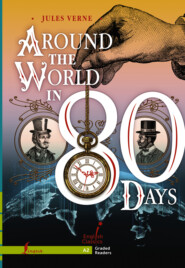По всем вопросам обращайтесь на: info@litportal.ru
(©) 2003-2024.
✖
From the Earth to the Moon, Direct in Ninety-Seven Hours and Twenty Minutes: and a Trip Round It
Настройки чтения
Размер шрифта
Высота строк
Поля
"On the receipt of your favour of the 6th inst., addressed to the Observatory of Cambridge in the name of the Members of the Baltimore Gun Club, our staff was immediately called together, and it was judged expedient to reply as follows: —
"The questions which have been proposed to it are these, —
"'1. Is it possible to transmit a projectile up to the moon?
"'2. What is the exact distance which separates the earth from its satellite?
"'3. What will be the period of transit of the projectile when endowed with sufficient initial velocity? and, consequently, at what moment ought it to be discharged in order that it may touch the moon at a particular point?
"'4. At what precise moment will the moon present herself in the most favourable position to be reached by the projectile?
"'5. What point in the heavens ought the cannon to be aimed at which is intended to discharge the projectile?
"'6. What place will the moon occupy in the heavens at the moment of the projectile's departure?'
"Regarding the first question, 'Is it possible to transmit a projectile up to the moon?'
"Answer. – Yes; provided it possess an initial velocity of 1200 yards per second; calculations prove that to be sufficient. In proportion as we recede from the earth the action of gravitation diminishes in the inverse ratio of the square of the distance; that is to say, at three times a given distance the action is nine times less. Consequently, the weight of a shot will decrease, and will become reduced to zero at the instant that the attraction of the moon exactly counterpoises that of the earth; that is to say, at 47/52 of its passage. At that instant the projectile will have no weight whatever; and, if it passes that point, it will fall into the moon by the sole effect of the lunar attraction. The theoretical possibility of the experiment is therefore absolutely demonstrated; its success must depend upon the power of the engine employed.
"As to the second question, 'What is the exact distance which separates the earth from its satellite?'
"Answer.– The moon does not describe a circle round the earth, but rather an ellipse, of which our earth occupies one of the foci; the consequence, therefore, is, that at certain times it approaches nearer to, and at others it recedes farther from, the earth; in astronomical language, it is at one time in apogee, at another in perigee. Now the difference between its greatest and its least distance is too considerable to be left out of consideration. In point of fact, in its apogee the moon is 247,552 miles, and in its perigee, 218,657 miles only distant; a fact which makes a difference of 28,895 miles, or more than one ninth of the entire distance. The perigee distance, therefore, is that which ought to serve as the basis of all calculations.
"To the third question: —
"Answer.– If the shot should preserve continuously its initial velocity of 12,000 yards per second, it would require little more than nine hours to reach its destination; but, inasmuch as that initial velocity will be continually decreasing, it results that, taking everything into consideration, it will occupy 300,000 seconds, that is 83hrs. 20m. in reaching the point where the attraction of the earth and moon will be in equilibrio. From this point it will fall into the moon in 50,000 seconds, or 13hrs. 53m. 20sec. It will be desirable, therefore, to discharge it 97hrs. 13m. 20sec. before the arrival of the moon at the point aimed at.
"Regarding question four, 'At what precise moment will the moon present herself in the most favourable position, &c.?'
"Answer. – After what has been said above, it will be necessary, first of all, to choose the period when the moon will be in perigee, and also the moment when she will be crossing the zenith, which latter event will further diminish the entire distance by a length equal to the radius of the earth, i.e. 3919 miles; the result of which will be that the final passage remaining to be accomplished will be 214,976 miles. But although the moon passes her perigee every month, she does not reach the zenith always at exactly the same moment. She does not appear under these two conditions simultaneously, except at long intervals of time. It will be necessary, therefore, to wait for the moment when her passage in perigee shall coincide with that in the zenith. Now, by a fortunate circumstance, on the 4th December in the ensuing year the moon will present these two conditions. At midnight she will be in perigee, that is, at her shortest distance from the earth, and at the same moment she will be crossing the zenith.
"On the fifth question, 'At what point in the heavens ought the cannon to be aimed?'
"Answer. – The preceding remarks being admitted, the cannon ought to be pointed to the zenith of the place. Its fire, therefore, will be perpendicular to the plane of the horizon; and the projectile will soonest pass beyond the range of the terrestrial attraction. But, in order that the moon should reach the zenith of a given place, it is necessary that the place should not exceed in latitude the declination of the luminary; in other words, it must be comprised within the degrees 0° and 28° of lat. N. or S. In every other spot the fire must necessarily be oblique, which would seriously militate against the success of the experiment.
"As to the sixth question, 'What place will the moon occupy in the heavens at the moment of the projectile's departure?'
"Answer. – At the moment when the projectile shall be discharged into space, the moon, which travels daily forward 13° 10' 35", will be distant from the zenith point by four times that quantity, i.e. by 52° 42' 20", a space which corresponds to the path which she will describe during the entire journey of the projectile. But, inasmuch as it is equally necessary to take into account the deviation which the rotary motion of the earth will impart to the shot, and as the shot cannot reach the moon until after a deviation equal to 16 radii of the earth, which, calculated upon the moon's orbit, are equal to about eleven degrees, it becomes necessary to add these eleven degrees to those which express the retardation of the moon just mentioned: that is to say, in round numbers, about 64 degrees. Consequently, at the moment of firing the visual radius applied to the moon will describe, with the vertical line of the place, an angle of sixty-four degrees.
"These are our answers to the questions proposed to the Observatory of Cambridge by the members of the Gun Club: —
"To sum up, —
"1st. The cannon ought to be planted in a country situated between between 0° and 28° of N. or S. lat.
"2ndly. It ought to be pointed directly towards the zenith of the place.
"3rdly. The projectile ought to be propelled with an initial velocity of 12,000 yards per second.
"4thly. It ought to be discharged at 10hrs. 46m. 40sec. of the 1st December of the ensuing year.
"5thly. It will meet the moon four days after its discharge, precisely at midnight on the 4th December, at the moment of its transit across the zenith.
"The members of the Gun Club ought, therefore, without delay, to commence the works necessary for such an experiment, and to be prepared to set to work at the moment determined upon; for, if they should suffer this 4th December to go by, they will not find the moon again under the same conditions of perigee and of zenith until eighteen years and eleven days afterwards.
"The Staff of the Cambridge Observatory place themselves entirely at their disposal in respect of all questions of theoretical astronomy; and herewith add their congratulations to those of all the rest of America.
"For the Astronomical Staff,
"J. M. BELFAST,
"Director of the Observatory of Cambridge."
CHAPTER V.
THE ROMANCE OF THE MOON
An observer endued with an infinite range of vision, and placed in that unknown centre around which the entire world revolves, might have beheld myriads of atoms filling all space during the chaotic epoch of the universe. Little by little, as ages went on, a change took place; a general law of attraction manifested itself, to which the hitherto errant atoms became obedient: these atoms combined together chemically according to their affinities, formed themselves into molecules, and composed those nebulous masses with which the depths of the heavens are strewed.
These masses became immediately endued with a rotary motion around their own central point. This centre, formed of indefinite molecules, began to revolve round its own axis during its gradual condensation; then, following the immutable laws of mechanics, in proportion as its bulk diminished by condensation, its rotary motion became accelerated, and these two effects continuing, the result was the formation of one principal star, the centre of the nebulous mass.
By attentively watching, the observer would then have perceived the other molecules of the mass, following the example of this central star, become likewise condensed by gradually accelerated rotation, and gravitating round it in the shape of innumerable stars. Thus was formed the Nebulæ, of which astronomers have reckoned up nearly 5000.
Amongst these 5000 nebulæ there is one which has received the name of the Milky Way, and which contains eighteen millions of stars, each of which has become the centre of a solar world.
If the observer had then specially directed his attention to one of the more humble and less brilliant of these stellar bodies, a star of the fourth class, that which is arrogantly called the Sun, all the phenomena to which the formation of the Universe is to be ascribed would have been successively fulfilled before his eyes. In fact, he would have perceived this sun, as yet in the gaseous state, and composed of moving molecules, revolving round its axis in order to accomplish its work of concentration. This motion, faithful to the laws of mechanics, would have been accelerated with the diminution of its volume; and a moment would have arrived when the centrifugal force would have overpowered the centripetal, which causes the molecules all to tend towards the centre.
Another phenomenon would now have passed before the observer's eye, and the molecules situated on the plane of the equator escaping, like a stone from a sling of which the cord had suddenly snapped, would have formed around the sun sundry concentric rings resembling that of Saturn. In their turn, again, these rings of cosmical matter, excited by a rotary motion round the central mass, would have been broken up and decomposed into secondary nebulosities, that is to say, into planets. Similarly he would have observed these planets throw off one or more rings each, which became the origin of the secondary bodies which we call satellites.
Thus, then, advancing from atom to molecule, from molecule to nebulous mass, from that to a principal star, from star to sun, from sun to planet, and hence to satellite, we have the whole series of transformations undergone by the heavenly bodies during the first days of the world.
Now, of those attendant bodies which the sun maintains in their elliptical orbits by the great law of gravitation, some few in their turn possess satellites. Uranus has eight, Saturn eight, Jupiter four, Neptune possibly three, and the Earth one. This last, one of the least important of the entire solar system, we call the Moon; and it is she whom the daring genius of the Americans professed their intention of conquering.
The moon, by her comparative proximity, and the constantly varying appearances produced by her several phases, has always occupied a considerable share of the attention of the inhabitants of the earth.
From the time of Thales of Miletus, in the fifth century b. c., down to that of Copernicus in the fifteenth and Tycho Brahé in the sixteenth century a. d., observations have been from time to time carried on with more or less correctness, until in the present day the altitudes of the lunar mountains have been determined with exactitude. Galileo explained the phenomena of the lunar light produced during certain of her phases by the existence of mountains, to which he assigned a mean altitude of 27,000 feet. After him Hévelius, an astronomer of Dantzic, reduced the highest elevations to 15,000 feet; but the calculations of Riccioli brought them up again to 21,000 feet.
At the close of the eighteenth century Herschell, armed with a powerful telescope, considerably reduced the preceding measurements. He assigned a height of 11,400 feet to the maximum elevations, and reduced the mean of the different altitudes to little more than 2400 feet. But Herschell's calculations were in their turn corrected by the observations of Halley, Nasmyth, Bianchini, Gruithuysen, and others; but it was reserved for the labours of Bœer and Mædler finally to solve the question. They succeeded in measuring 1905 different elevations, of which six exceed 15,000 feet, and twenty-two exceed 14,400 feet. The highest summit of all towers to a height of 22,606 feet above the surface of the lunar disc. At the same period the examination of the moon was completed. She appeared completely riddled with craters, and her essentially volcanic character was apparent at each observation. By the absence of refraction in the rays of the planets occulted by her we conclude that she is absolutely devoid of an atmosphere. The absence of air entails the absence of water. It became, therefore, manifest that the Selenites, to support life under such conditions, must possess a special organization of their own, must differ remarkably from the inhabitants of the earth.
At length, thanks to modern art, instruments of still higher perfection searched the moon without intermission, not leaving a single point of her surface unexplored; and notwithstanding that her diameter measures 2150 miles, her surface equals the 1-15th part of that of our globe, and her bulk the 1-49th part of that of the terrestrial spheroid – not one of her secrets was able to escape the eyes of the astronomers; and these skilful men of science carried to even greater degree their prodigious observations.
Thus they remarked that, during full moon, the disc appeared scored in certain parts with white lines; and, during the phases, with black. On prosecuting the study of these with still greater precision, they succeeded in obtaining an exact account of the nature of these lines. They were long and narrow furrows sunk between parallel ridges, bordering generally upon the edges of the craters. Their length varied between ten and 100 miles, and their width was about 1600 yards. Astronomers called them chasms, but they could not get any farther. Whether these chasms were the dried-up beds of ancient rivers or not they were unable thoroughly to ascertain.
The Americans, amongst others, hoped one day or other to determine this geological question. They also undertook to examine the true nature of that system of parallel ramparts discovered on the moon's surface by Gruithuysen, a learned professor of Munich, who considered them to be "a system of fortifications thrown up by the Selenitic engineers." These two points, yet obscure, as well as others, no doubt, could not be definitively settled except by direct communication with the moon.
Regarding the degree of intensity of its light, there was nothing more to learn on this point. It was known that it is 300,000 times weaker than that of the sun, and that its heat has no appreciable effect upon the thermometer. As to the phenomenon known as the "ashy light," it is explained naturally by the effect of the transmission of the solar rays from the earth to the moon, which give the appearance of completeness to the lunar disc, while it presents itself under the crescent form during its first and last phases.
Such was the state of knowledge acquired regarding the earth's satellite, which the Gun Club undertook to perfect in all its aspects, cosmographic, geological, political, and moral.

















